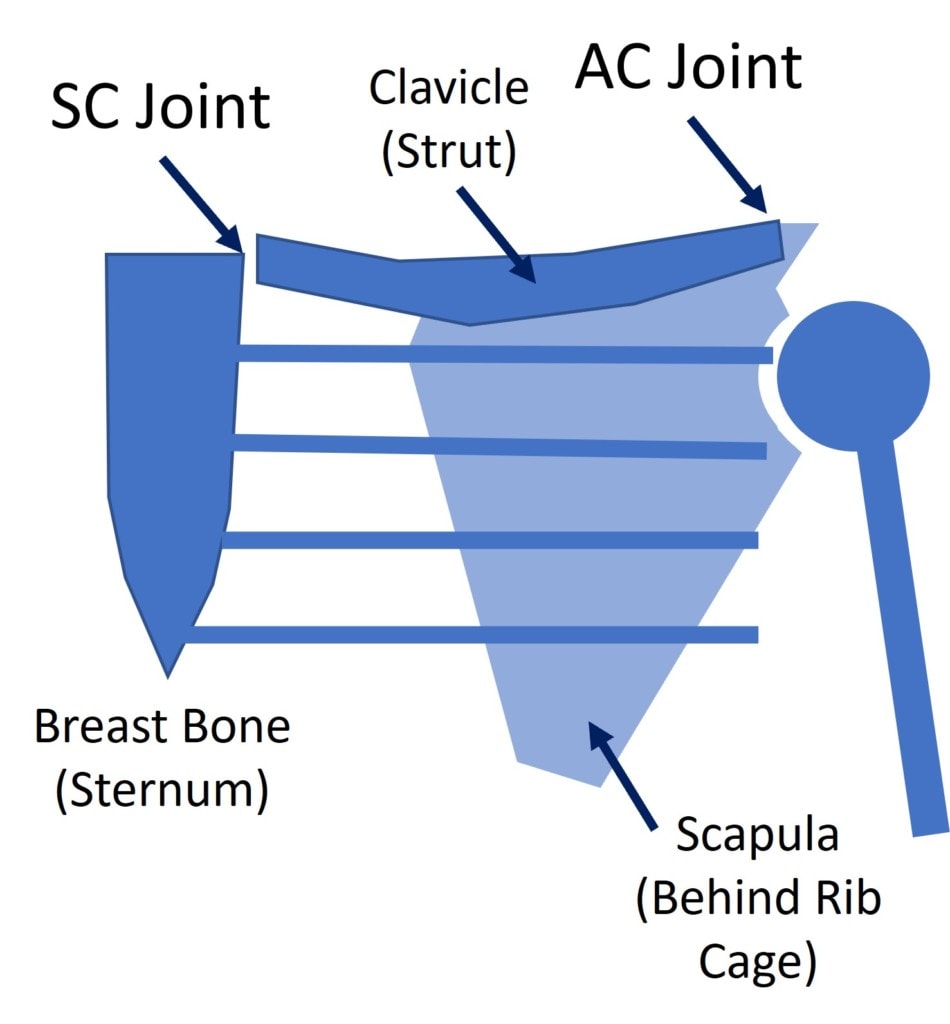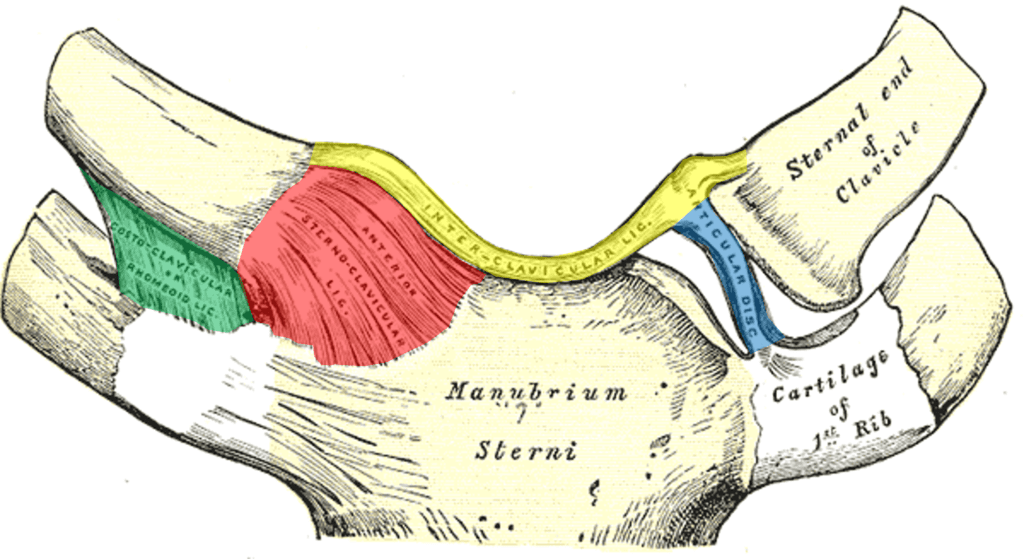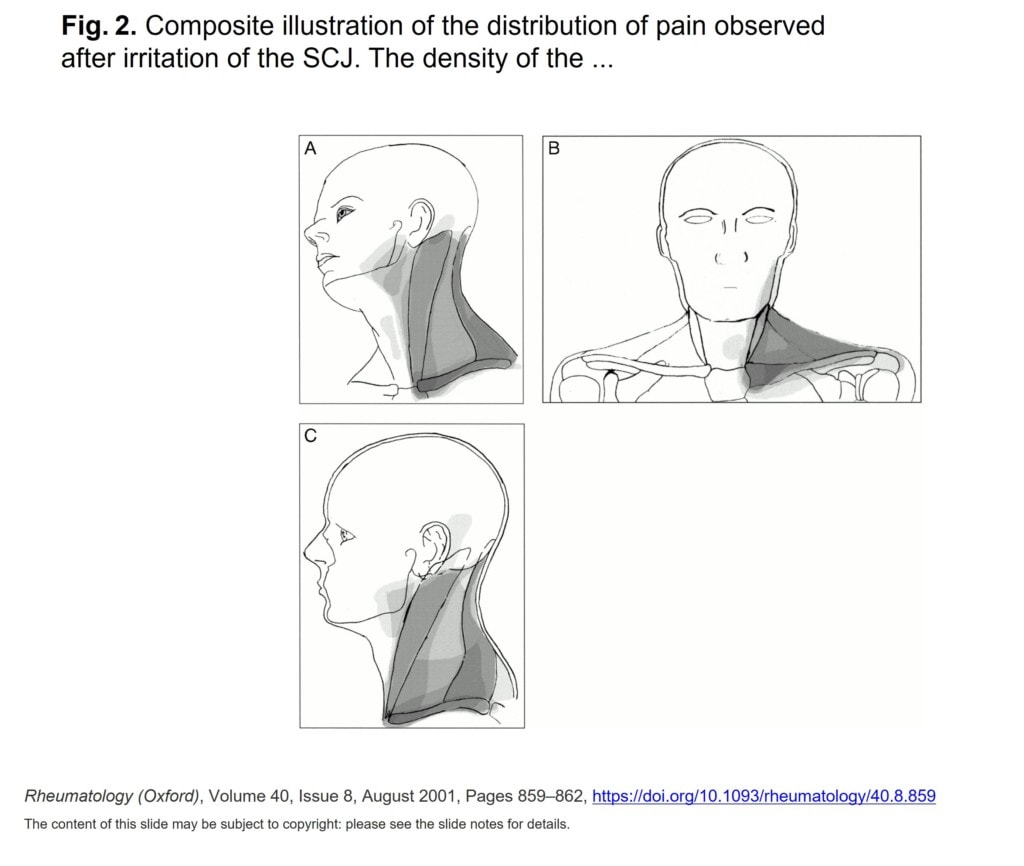Stenoclavicular Joint Pain?
How is your shoulder connected to your body and how does that relate to the Sternoclavicular joint? What is Sternoclavicular joint pain? This blog will discuss:
- What is the Sternoclavicular joint?
- How is the joint put together?
- Why does this joint hurt? What kind of pain does it generate?
- How does the joint work?
- How is the problem diagnosed?
- How is the painful joint treated?
Getting Old
I have a love-hate relationship with getting old. On the one hand, getting old isn’t for sissies. On the other, the musculoskeletal problems that crop up are a fantastic educational tool for a doctor. So today we’ll go over the Sternoclavicular joint pain I’m having what I’m going to do about it. Let’s dig in.
What Is the Sternoclavicular Joint?

The Sternoclavicular (SC) joint is between your breast and collar bone and is about the size of a large thumb joint. It has cartilage and ligaments that hold it in place.
The Structure of the Sternoclavicular Joint

Credit: Wikipedia
What can the structure of the SC joint tell us about Sternoclavicular joint pain? Let’s dive in.
The Sternoclavicular joint is made up of the cartilage on the Sternum and on the end of the Clavicle. There’s also a fibrous disc (blue) as in other joints such as the TMJ. The joint is surrounded and held together by ligaments that also guide normal motion:
- Interclavicular ligament (yellow)-This travels along the top of the joint and connects one side to the other.
- Anterior Sternoclavicular Ligament (red)-This holds the clavicle back from dislocating forward.
- Sternoclavicular Rhomboid Ligament (green)-This helps stabilize the motion of the clavicle by anchoring it to the first rib.
Sternoclavicular Joint Pain
The SC joint can be injured with shoulder or body trauma and can become degenerative and get arthritis like any joint. When you experience Sternoclavicular joint pain, while the joint itself can hurt, interestingly it can also refer pain to the side of the neck and upper trap (1):

What Does the Sternoclavicular Joint Do?
Have you ever thought about how your shoulder joint complex attaches to your body? Those attachments are critical for force transfer and stability. Let’s dive in.
As you can see, the Sternoclavicular (SC) joint lives between the Sternum (breast bone) and Clavicle (collar bone). All of that attaches to the AC joint which attaches to the Scapula (shoulder blade). All of this is a mechanical force linkage system:

As you can see above, the SC and AC joints transfer forces from your arm through your shoulder to your sternum, which is your core. Said another way, this is a strut system not that different than the suspension on your car that transfers forces from the ground, wheel, and to the body. Hence, when you have Sternoclavicular pain, this is often felt when you pick up stuff with your arms.
How Do You Know if You Have Sternoclavicular Joint Problems?
One of the problems I’ve seen as a physician who treats Sternoclavicular joint pain is that it’s the red-headed stepchild of shoulder pain. Meaning that getting a doctor to diagnose this as your problem can be difficult as 99% of Orthopedic surgeons will never perform an examination of this area. The percentage of musculoskeletal experts who know about this joint and its problems is less than 1 in 100.
Hands-on Exam
Who is the most likely person to help you get to the right diagnosis for Sternoclavicular joint pain? In my experience, it’s often a manually trained physical therapist. These experts can look at the movement patterns and see if the SC joint is moving correctly.
What type of exam should be performed? These are the critical elements:
- Palpation – pressing on the joint to see if it hurts
- Movement – This is usually palpating the joint while the patient moves the arm and shoulder in various ways. The goal is to determine if the pattern of motion is normal.
- Stability – The provider can push on the joint to see if moves too much. That means that the ligaments are lax or damaged.
Imaging
Imaging small joints in the body is never as easy as getting a great picture of large joints. However, while imaging the Sternoclavicular joint is tough with x-rays, MRI and CT scans can image the joint reasonably well.
However, imaging instability is much harder. Instability means that the joint moves around too much due to loose or damaged ligaments. Ultrasound imaging of the moving joint can sometimes capture this problem, but it’s often a hands-on diagnosis.
Sternoclavicular Joint Treatment
If you have Sternoclavicular joint pain, what are your options?
Physical Therapy
About 1 in 10 physical therapists have hands-on manual medicine training. These physical therapists can not only diagnose Sternoclavicular joint issues but can also guide the joint back to normal function while they help you attain normal posture and strengthen the surrounding rotator cuff and scapular muscles.
Steroid Injection
Injecting high-dose steroids into joints is a common practice. While these drugs are potent anti-inflammatories, we now know they destroy joint cartilage and worsen arthritis (2). Hence, we now avoid this practice.
Orthobiologics
If physical therapy fails, the next step is now Orthobiologics. What’s that?
To do this right, you need to use ultrasound imaging to inject the joint as well as the ligaments that guide the normal movement of the joint. The most commonly used Orthobiologic is platelet-rich plasma (PRP) which is generally, in my clinical experience, highly effective for SC point pain.
Sternoclavicular Joint Reconstruction
Surgery is an option for Sternoclavicular joint pain, but in my clinical experience, the vast majority of patients won’t need this more invasive approach. In the rare instances when it is needed, the procedure involves drilling holes into the bones and stringing a tendon to take the place of severely damaged ligaments.
My Sternoclavicilar Joint Story
I’ve never before noticed Sternoclavicular joint pain. However, this past month I’ve been introduced to it with activity-related pain that refers to the side of my neck.
From having experience treating hundreds of patients with Sternoclavicular joint pain, I can feel that my anterior ligament is loose, meaning the joint is unstable. I’ve tried mobilizing it back into place and tried to get it to seat better in the joint, but that only aggravates the problem, so it’s unlikely that physical therapy will help.
How did this happen? I’ve been a big weightlifter, so my SC joints get lots of force transmitted through them. However, I think my recent weight loss and loss of my middle age belly have allowed me to begin improving my posture. Through the years, my SC ligaments have gotten stretched out and now that I can remove the daily pressure off of them, they’re now loose and unstable. So what’s my next step? To get precise PRP injections into the ligaments to tighten those down. That should resolve the issue.
What would happen if I didn’t treat this problem? I would get arthritic and painful SC joints, hence I’m getting this treated next week.
The upshot? Sternoclavicular joint pain is a real thing that’s often underdiagnosed or missed by Orthopedic surgeons. However, getting to a diagnosis is easy if the provider is trained to recognize this problem. In addition, specific physical therapy can help as well as precise Orthobiologic injections. The good news is that surgery is rarely needed!
____________________________________________________
References:
(1) G. Hassett, L. Barnsley, Pain referral from the sternoclavicular joint: a study in normal volunteers, Rheumatology, Volume 40, Issue 8, August 2001, Pages 859–862, https://doi.org/10.1093/rheumatology/40.8.859
(2) McAlindon TE, LaValley MP, Harvey WF, et al. Effect of Intra-articular Triamcinolone vs Saline on Knee Cartilage Volume and Pain in Patients With Knee Osteoarthritis: A Randomized Clinical Trial. JAMA.2017;317(19):1967–1975. doi: 10.1001/jama.2017.5283

If you have questions or comments about this blog post, please email us at [email protected]
NOTE: This blog post provides general information to help the reader better understand regenerative medicine, musculoskeletal health, and related subjects. All content provided in this blog, website, or any linked materials, including text, graphics, images, patient profiles, outcomes, and information, are not intended and should not be considered or used as a substitute for medical advice, diagnosis, or treatment. Please always consult with a professional and certified healthcare provider to discuss if a treatment is right for you.